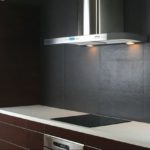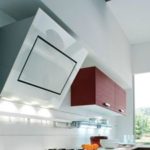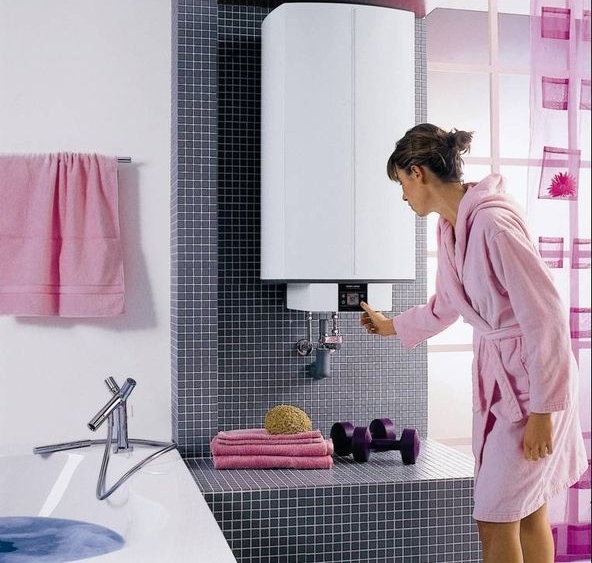Do you need a hood in a kitchen with an electric stove?
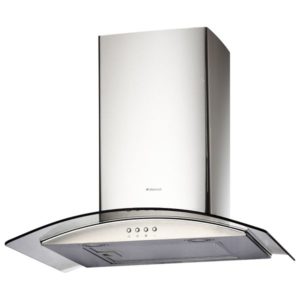 A hood is a device necessary for everyone who cares about their health. Is it healthier to breathe clean air - or polluted air and full of mixed, not always pleasant aromas? Therefore, you shouldn’t even think about whether you need a hood in a kitchen with an electric stove.
A hood is a device necessary for everyone who cares about their health. Is it healthier to breathe clean air - or polluted air and full of mixed, not always pleasant aromas? Therefore, you shouldn’t even think about whether you need a hood in a kitchen with an electric stove.
A kitchen hood purifies the air. Depending on the type of device, cleaning is carried out in two ways. This:
- recirculation of kitchen air by forcing it through special filters that remove harmful substances, fat, soot, and unpleasant odors;
- replacing indoor air with fresh air by removing “waste material” through air ducts into the external environment or ventilation shafts.
IMPORTANT. An exhaust system with an external outlet is definitely undesirable if you have an instantaneous water heater installed - a gas water heater: there is a risk of disrupting the draft in the ventilation well and creating problems with air removal. There is a case when a hood is simply not needed - the food is not prepared at home (ordered or heated in the microwave). But sooner or later, everything that is needed for a kitchen hood still happens. This includes hookah, paint smells and much more.
The content of the article
Which model should you choose? Decide by evaluating the features of each
Advantages of models with recirculation:
- well suited for kitchens with traditional gas stoves - they remove harmful impurities and grease from the atmosphere, but have little control over odor, and this is important for kitchens with electric stoves;
- easy to install - you can install it yourself;
- have a nice design;
- budgetary;
- save energy;
- do not “drive” heat out of the room.
Disadvantage: the need to replace filters occurs every 3-5 months, depending on the rate of operation.

Models with air ducts or flow-through have the following advantages:
- their productivity is higher;
- no filter replacement required.
Minuses:
- their installation requires connection to the kitchen ventilation system, therefore, installation will be more expensive and must be carried out by specialists;
- installation of an anti-return valve is required - otherwise “exhaust” air will flow into the room from the ventilation shaft;
- Not everyone likes the bulky hood of a flow-through hood - it spoils the design (unless you have a loft, of course!).
If it’s difficult to decide, there are models that combine both modes (exhaust with recirculation).
Why do you need a hood: disadvantages of kitchens without hoods
Why do you need a hood in the kitchen above the stove? And in order to keep the apartment fresh and leave the renovation in good condition for a long time.
If you do not install a hood in a kitchen that is actively used for cooking, after some time even the most attractive designer interior will begin to resemble the “black hut” of our ancestors (such a hut did not have a chimney pipe, ventilation was carried out through doors and windows - as a result, the inside of the house was various shades of black from stove smoke). Without hood:
- grease, soot and fumes will perfectly settle on beautiful modern materials, mix with dust and decide to stay forever: washing wall and floor tiles and plastic furniture from dried yellow stains is not much fun, but a lot of time is wasted;
- wooden surfaces are even more difficult to clean: they more readily absorb various substances and are easily damaged when scrubbed;
- textiles are also a lover of “perfumery” from all pungent odors: it absorbs them perfectly! Curtains fragrant with the stale aroma of barbecue - is this what you dreamed of?
IMPORTANT. Many modern interiors use a “single space” design solution - that is, kitchen dirt and dubious culinary aromas have an increased chance of spreading throughout the entire space of the apartment. Upholstered furniture that smells like fish, soot on the plasma screen... In this case, an exhaust hood is required!

But it's not just about aesthetics! Being in the kitchen without a hood is harmful to health, especially for housewives who have been using the gas stove for a long time. Household gas, even when burned completely, deteriorates the atmosphere, “burning” oxygen out of it and increasing the concentration of carbon dioxide. But the main danger comes from its combustion products:
- carbon monoxide is otherwise expressively called carbon monoxide (if its concentration is exceeded, ailments, headaches, allergic reactions, and a general decline in immunity are guaranteed);
- sulfur dioxide (poisonous, in low concentrations it causes a sore throat, cough, runny nose, and sometimes causes an allergic reaction);
- nitrogen oxides (cause an increase in the effort spent on breathing, making a person more susceptible to respiratory diseases);
- formaldehyde (in the form of a gas, it is harmful to the skin and mucous membranes, a carcinogen);
- benzopyrene (a powerful carcinogen, and a housewife who spends a lot of time over a gas stove seems to smoke from 2 to 5 cigarettes a day, even if she is categorically against smoking!).
IMPORTANT. If the hood has not yet been installed, try:
- turn on no more than two burners at the same time (option: burner and oven);
- turn off the stove after every 2 hours of continuous operation and ventilate the kitchen;
- When the stove is operating, close the door leading to the kitchen and open the window, otherwise all the “nasty” will go into the rooms.
During cooking, substances are also formed that have a negative effect on the human body. Particularly dangerous is such a process, known to all housewives, as frying in an open frying pan. The more the frying surface heats up, the more actively unfavorable chemical processes occur:
- When frying meat, fish and other products, water or ammonia is split off from organic molecules, and the so-called formation occurs. “unsaturated compounds”, they also decompose, and vapors are obtained that cause us to cough - aldehydes, and acrolein is especially harmful. This substance is excellent for chemical synthesis, but is extremely undesirable in the human body, it is carcinogenic;
- if the product in the frying pan is burnt, charred - and many people like meat fried to this state - it is worth considering: this crust is not only tasty, but also dangerous, it contains coronene, benzopyrene, perylene, chrysene, dibenzapyrene, and all of them have carcinogenic properties;
- The coating on the pan itself can also release dangerous fluoride compounds.
The odors generated during the cooking process are also not as harmless as they might seem:
- discomfort and the ability to be absorbed are not their main danger (although there are people who cannot tolerate certain odors to the point of vomiting to them - cooking fish, meat products, certain vegetables, you should not neglect the comfort of your loved ones);
- many food odors can cause allergies (if there is a small child in the family, the parents may not yet know what his body is capable of producing an allergic reaction to, do not risk it);
- Older people often have age-related breathing problems due to various diseases - they also need clean air.

IMPORTANT. If there are “opponents of a healthy lifestyle” in the family - people who smoke in the kitchen - the need for a hood is completely obvious.
Differences between an electric stove and a gas stove
From the point of view of benefits/harm for health and aesthetics of space, an electric stove compares favorably with a gas stove:
- does not emit carbon monoxide and other toxic combustion products of household gas;
- will not “decorate” your bright interior with a yellow coating - a film that is inevitable where gas burners operate.
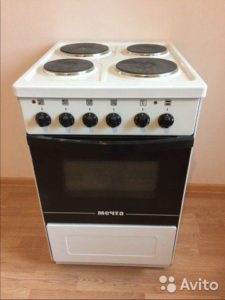
But when using an electric stove for its intended purpose - for cooking - the same processes occur:
- active evaporation of moisture;
- release of harmful substances formed when heating metals and products;
- formation of odors and fumes;
- the appearance of kitchen dirt - grease and soot.
Is it advisable to install an exhaust system above an electric stove? Yes, if the kitchen is large enough and it is impossible to provide high-quality ventilation using the traditional “window” method.
IMPORTANT. A hood can make the kitchen more ergonomic: after all, you can’t hang a cabinet or shelf directly above the electric stove, but above the exhaust hood - please!
Should I install a hood over a gas stove?
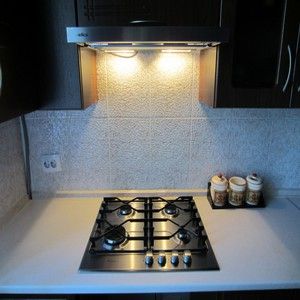 Not only worth it, but highly desirable! Modern designers don’t ask themselves whether it’s possible to have a kitchen without a hood? Compare the disadvantages of a gas stove with the benefits of the exhaust system. One-time cost for installing a hood - or:
Not only worth it, but highly desirable! Modern designers don’t ask themselves whether it’s possible to have a kitchen without a hood? Compare the disadvantages of a gas stove with the benefits of the exhaust system. One-time cost for installing a hood - or:
- potential costs for poor health,
- Regular expenses for repairs (even cosmetic ones) of a terrible-looking kitchen?
IMPORTANT. Turn on the hood a few minutes before the start of the cooking process - and turn it off no earlier than 10-15 minutes later; turning it off too quickly harms the system and does not allow you to properly clean the air.


